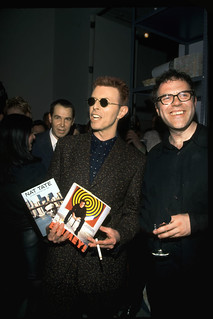
PREV ARTICLE
NEXT ARTICLE
FULL ISSUE
PREV FULL ISSUE
THE BIGGEST ART HOAX IN HISTORY?Speaking of fakes, here's another non-numismatic biggie from the art world that i happened across this week. I missed the news
when it first took place, but there was a studendous April Fools prank in the 1990s. Here's a participant's tale from his April 1, 2011
Harper's Bazaar article. -Editor
At one stage in the evening, Bowie read some excerpts from a short biography 21 was publishing. It was called Nat Tate: An American Artist: 1928--1960. It was full of photographs and illustrations, and it was written by me. Nat Tate was a short-lived member of the famous New York School, which flourished in the late 1940s and 1950s and included such luminaries as Jackson Pollock, Franz Kline, and Willem de Kooning. Tate committed suicide in 1960 by jumping off the Staten Island Ferry (his body was never found) after having burned 99 percent of his life's work during the last weekend of his life. Hence the artistic oblivion he found himself in almost 40 years later; only a few works remained to testify to his intriguing talent. After Bowie gave his reading, an English journalist named David Lister, who worked for the Independent newspaper in London--a national newspaper--wandered through the crowd in Koons's studio, chatting to people about Tate. Some people claimed to have heard of him, a few had seen some of the work, and all agreed that his short, abruptly self-terminated life was very sad. A week later, 21 Publishing planned a similar launch in London. A new restaurant, Mash, was the venue, and, just as in New York, much of London's art world had been invited. I gave major interviews on BBC Radio and to national newspapers. The eminent journalists who interviewed me were hugely intrigued by this forgotten American artist, highly curious as to how I had found out about this overlooked talent. An excerpt from the book ran in the Sunday Telegraph. And then it was all exposed as an elaborate hoax. Nat Tate had never existed. Nat Tate was a fiction. He was a figment of William Boyd's imagination. The hoax was broken by Lister, the English journalist at the Bowie-Koons party. He was one of the very small band of conspirators and felt he couldn't sit on this scoop any longer, and the story duly appeared on the front page of the Independent: HOW A BRITISH NOVELIST FOOLED THE U.S. ART WORLD. It was picked up internationally (it was on the front page of the New York Times Arts section), and for 24 hours it became a global talking point. I was interviewed by radio stations and newspapers around the world. I was on Voice of America. I had a 20-minute interview on the late-night news-magazine program on BBC TV. And so on and so forth. And thus the myth of the great Nat Tate art hoax was born. It wasn't planned this way. Nat Tate was created out of a desire to experiment--to see if something entirely fictitious could experience a life in the world as something wholly credible, real, and true. I wanted to launch the book out into the public arena and see what would happen, to see who bought the story wholesale and who was suspicious. I wondered how long it would take for us to be rumbled. A month? Six months? A year or so? At the time, I was on the editorial board of an art magazine called Modern Painters, as was David Bowie, which is how we met. With the editor's cooperation, I came up with the idea of creating an imaginary painter. However, his life would be tricked out with absolute authenticity: photographs, reminiscences, examples of surviving artwork. Bowie suggested we publish it as a small, beautifully produced art monograph. For me, the key ingredient was the testimony of people who could "remember" meeting Tate. I asked two friends--Gore Vidal and Picasso biographer John Richardson--to join the circle of conspirators. Their anecdotal testimony in the book acts with massive veridical force. Here is Gore Vidal on meeting Tate: He was "an essentially dignified drunk with nothing to say. Unlike most American painters, he was unverbal." Then Richardson describes how he introduced Tate to Picasso at a luncheon and then gained him access to Braque in his studio at Varengeville in Normandy: "It was obvious that Tate had a drink problem ... but I found him charming and unassuming." The evidence was overwhelming. It must be true. Nat Tate must have existed. And here we are, 13 years after the event, and the phenomenon has never stopped. There have been three TV documentaries about Tate. The biography has been translated into French and German and will be republished in the U.K. and the U.S. this month. In the 2010 TV dramatization of my novel Any Human Heart, Tate is played by the actor Theo Cross. And, even more bizarrely, the first authenticated Tate drawing to go on the open market is about to be auctioned in London. To read the complete article, see: Wayne Homren, Editor The Numismatic Bibliomania Society is a non-profit organization promoting numismatic literature. See our web site at coinbooks.org. To submit items for publication in The E-Sylum, write to the Editor at this address: whomren@gmail.com To subscribe go to: https://my.binhost.com/lists/listinfo/esylum All Rights Reserved. NBS Home Page Contact the NBS webmaster 
|
